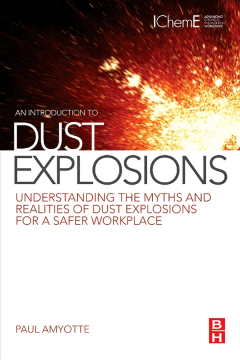
Additional Information
Book Details
Abstract
Preventable dust explosions continue to occur in industry in spite of significant research and practice efforts worldwide over many years. There is a need for effective understanding of the unique hazards posed by combustible dust. This book describes a number of dust explosion myths – which together cover the main source of dust explosion hazards – the reasons they exist and the corresponding scientific and engineering facts that mitigate these circumstances.
An Introduction to Dust Explosions describes the main erroneous beliefs about the origin and propagation of dust explosions. It offers fact-based explanations for their occurrence and the impact of such events and provides a critical guide to managing and mitigating dust explosion risks.
- Designed to prevent accidents, injury, loss of life and capital damage
- An easy-to-read, scientifically rigorous treatment of the facts and fictions of dust explosions for those who need to – or ought to – understand dust explosions, their occurrence and consequences
- Enables the management and mitigation of these critical industrial hazards
"Amyotte arranges his treatment around 20 common myths about dust explosions, and the realities they hide, with a further organization by elements of the explosion pentagon: fuel, ignition source, oxidant, mixing, and confinement. Among the myths are dust explosions happen only in coal mines and grain elevators; dust ignites only with a high-energy ignition source; taking away the oxygen makes things safe; airborne dust will quickly settle out of suspension..."--ProtoView.com, January 2014 "For those working with powders and dusts, then this small, unusual book makes entertaining and interesting reading…The book should be essential reading for all managers, engineers, and scientists working in the chemical and related industries (e.g., food, where dust explosions are, unfortunately, quite common), since all dust explosions are preventable if the correct equipment is installed, the correct procedures are followed, and staff are properly trained."--Organic Process Research & Development online, December 24, 2013
